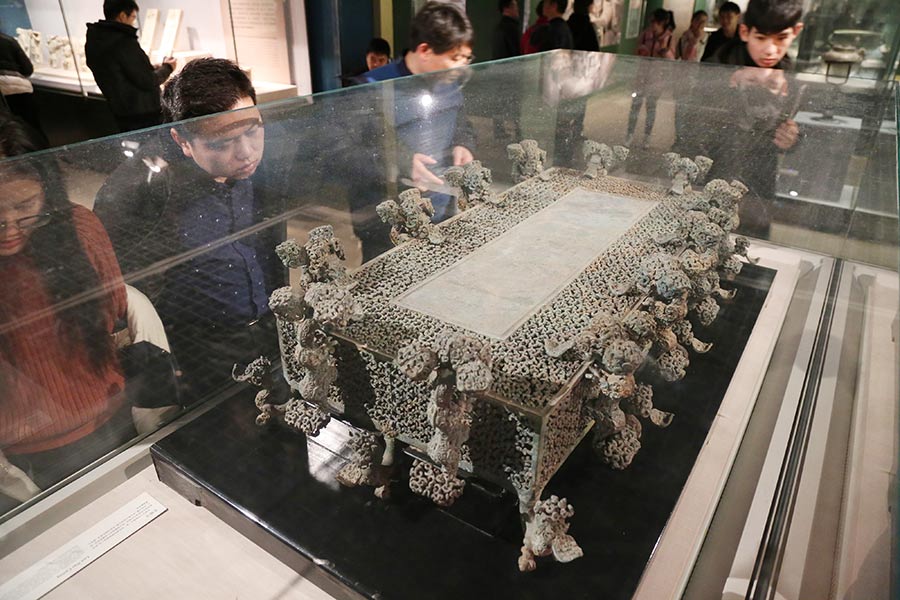 |
|
Bronze jin with cloud-shaped decorations [Photo by Zuo Dongchen/Asianewsphoto] |
The hit cultural exploration TV program, National Treasure, which uses theatrical play and other art forms to tell the story behind each of the country's top cultural relics from nine major museums nationwide, has come to end.
The show won much acclaim from audiences and stirred the public's interest in exploring treasures from the museums. During the show, three national treasures from each museum were presented in one episode, and the top nine relics were selected in the last episode.
The selected nine national treasures were later displayed in a digital show at the Palace Museum in Beijing in February, marking the museum's first exhibition opening in 2018.
Now, let's review the top nine national treasures from the show.
1. Stone drum from the Palace Museum
During the show, Hong Kong actor Tony Leung Ka-fai played Northern Song Dynasty (960-1127) statesman Sima Guang, who preserved a stone drum incised with hundreds of characters in seal script dating back to the Qin state during the Warring States Period (475-221 BC).
First discovered in Tianxing in Northwest China's Shaanxi province in the early Tang Dynasty (618-907), the stone drums were highly extolled by many Tang scholars, like Wei Yingwu and Han Yu. Both composed shi gu ge (Tribute to the Stone Drums) to eulogize the outstanding calligraphy on the stone drums. The inscriptions, known as the earliest set of Chinese characters carved on stone, are simple yet forceful, describing activities such as fishing, hunting and warfare. They also provided inspiration for many calligraphers who specialized in seal script.
2. Qin Dynasty bamboo slips from Hubei Provincial Museum
The 1,155 Qin Dynasty (221-206 BC) bamboo slips unearthed at Shuihudi Qin tomb in Yunmeng county of Central China's Hubei province include over 40,000 characters written in clerical script, making these the most comprehensive legal documents from the Qin Dynasty, with the largest quantity discovered so far. The pieces offer the world another perspective about the first unification of the Chinese nation.
These bamboo slips were copied by a grass-roots official named Xi (Joy) from the Qin Dynasty, who was buried with these copies after death. On the show, Sa Beining, a TV anchorman famous for his program about the law, plays Xi in the drama, adding a lot of fun to the show.
3. Bronze jin with cloud-shaped decorations from Henan Museum
Chinese actor Lei Jiayin plays the owner of the bronze jin with cloud-shaped decorations, Prince Zigeng, son of King Zhuang of Chu. Unearthed in Xichuan county of Central China's Henan province in 1978, the bronze jin, an artifact of the Spring and Autumn Period (770-476 BC), was a table to hold wine vessels during rituals.
Jin, meaning "forbidden", was also made to warn against the alcohol abuse that led to the downfall of the Xia (c. 21st century-16th century BC) and Shang (c. 16th century-11th century BC) dynasties.
This delicate artwork is one of the earliest bronze objects unearthed in China made by using the lost-wax casting technique. The Chinese government has listed the bronze jin as one of the 64 cultural relics that are forever forbidden to be exhibited abroad.